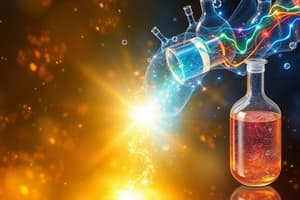Podcast
Questions and Answers
In an electrochemical cell, if the standard reduction potential of the cathode is +0.34 V and the standard cell potential is +0.76 V, what is the standard reduction potential of the anode?
In an electrochemical cell, if the standard reduction potential of the cathode is +0.34 V and the standard cell potential is +0.76 V, what is the standard reduction potential of the anode?
- +0.42 V
- -0.42 V (correct)
- -1.10 V
- +1.10 V
Which of the following statements correctly describes the relationship between the Gibbs free energy change (ΔG) and the cell potential (E) in an electrochemical reaction under non-standard conditions?
Which of the following statements correctly describes the relationship between the Gibbs free energy change (ΔG) and the cell potential (E) in an electrochemical reaction under non-standard conditions?
- ΔG and E are inversely related; a positive E indicates a negative ΔG, signifying a spontaneous reaction. (correct)
- ΔG is always positive when E is positive, indicating a spontaneous reaction.
- ΔG is zero when E is at its maximum value.
- ΔG is directly proportional to E, meaning that if E doubles, ΔG also doubles.
In an electrolytic cell, the anode is considered negative because it is connected to the negative terminal of the external power source, which attracts anions for oxidation.
In an electrolytic cell, the anode is considered negative because it is connected to the negative terminal of the external power source, which attracts anions for oxidation.
False (B)
A voltaic cell is constructed with a zinc anode and a copper cathode. Write cell notation for this voltaic cell.
A voltaic cell is constructed with a zinc anode and a copper cathode. Write cell notation for this voltaic cell.
In the electrolysis of water, the volume of ______ gas produced is typically twice the volume of oxygen gas produced.
In the electrolysis of water, the volume of ______ gas produced is typically twice the volume of oxygen gas produced.
Match each term with its correct description in the context of electrochemistry:
Match each term with its correct description in the context of electrochemistry:
During the operation of a rechargeable lithium-ion battery, which process occurs at the cathode during discharge?
During the operation of a rechargeable lithium-ion battery, which process occurs at the cathode during discharge?
Iron corrodes more readily in the presence of salt water than in fresh water. Which of the following explains why?
Iron corrodes more readily in the presence of salt water than in fresh water. Which of the following explains why?
A metal object is plated with a layer of gold using an electrolytic cell. If a current of 2.0 A is applied for 30 minutes, and knowing that the molar mass of gold is 197 g/mol and the number of electrons transferred in the gold plating process is 3, what is the mass of gold deposited on the object? (Faraday constant = 96485 C/mol)
A metal object is plated with a layer of gold using an electrolytic cell. If a current of 2.0 A is applied for 30 minutes, and knowing that the molar mass of gold is 197 g/mol and the number of electrons transferred in the gold plating process is 3, what is the mass of gold deposited on the object? (Faraday constant = 96485 C/mol)
Increasing the temperature of a voltaic cell will always increase the cell potential (Ecell), because higher temperatures favor the forward reaction.
Increasing the temperature of a voltaic cell will always increase the cell potential (Ecell), because higher temperatures favor the forward reaction.
Flashcards
Electrochemistry
Electrochemistry
Chemical processes involving electron movement.
Redox Reactions
Redox Reactions
Transfer of electrons between chemical species.
Oxidation
Oxidation
Loss of electrons by a molecule, atom, or ion.
Reduction
Reduction
Signup and view all the flashcards
Oxidizing Agent
Oxidizing Agent
Signup and view all the flashcards
Reducing Agent
Reducing Agent
Signup and view all the flashcards
Voltaic Cells
Voltaic Cells
Signup and view all the flashcards
Electrolytic Cells
Electrolytic Cells
Signup and view all the flashcards
Anode
Anode
Signup and view all the flashcards
Cathode
Cathode
Signup and view all the flashcards
Study Notes
- Electrochemistry is the study of chemical processes that cause electrons to move.
- Electricity is generated by movements of electrons from one element to another.
- These movements of electrons occur during a reaction known as an oxidation-reduction ("redox") reaction.
Redox Reactions
- Redox reactions involve electron transfer between chemical species.
- Oxidation involves the loss of electrons.
- Reduction involves the gain of electrons.
- Oxidizing agents cause oxidation and gain electrons and are thus reduced.
- Reducing agents cause reduction and lose electrons and are thus oxidized.
- Oxidation state/number indicates the degree of oxidation of an atom in a chemical compound.
- Oxidation states are assigned based on these rules:
- Free elements have an oxidation state of 0.
- Monatomic ions have an oxidation state equal to their charge.
- Oxygen usually has an oxidation state of -2, except in peroxides (-1) or with fluorine.
- Hydrogen usually has an oxidation state of +1, except in metal hydrides (-1).
- Fluorine always has an oxidation state of -1.
- The sum of oxidation states in a neutral molecule or ion equals its charge.
- Balancing redox reactions is achieved through the half-reaction method.
- The half-reaction method separates the oxidation and reduction processes into half-reactions.
Electrochemical Cells
- Electrochemical cells convert chemical energy into electrical energy or vice versa.
- Voltaic (galvanic) cells use spontaneous redox reactions to generate electricity.
- Electrolytic cells use electrical energy to drive non-spontaneous redox reactions (electrolysis).
Voltaic Cells
- A voltaic cell consists of two half-cells, each with an electrode in an electrolyte solution.
- Oxidation occurs at the anode.
- Reduction occurs at the cathode.
- A salt bridge connects the two half-cells and allows ion flow, maintaining charge neutrality.
- Electrons flow from the anode to the cathode through an external circuit, producing an electric current.
- Cell notation represents the voltaic cell, with the anode on the left and the cathode on the right.
- Double vertical lines separate the anode and cathode, indicating the salt bridge.
- Electromotive force (EMF), or cell potential (Ecell), is the potential difference between the cathode and anode.
- Cell potential measures the spontaneity of the redox reaction.
- Standard cell potential (E°cell) is measured under standard conditions (298 K, 1 atm for gases, 1 M for solutions).
- E°cell = E°(cathode) - E°(anode), where E° is the standard reduction potential.
- Standard reduction potentials are given for reduction half-reactions.
- The more positive the E° value, the greater the tendency for the species to be reduced.
- A positive E°cell indicates a spontaneous reaction (galvanic cell).
- A negative E°cell indicates a non-spontaneous reaction.
- Gibbs free energy change (ΔG) relates to the cell potential.
- ΔG = -nFE, where n is the number of moles of electrons transferred and F is the Faraday constant (96485 C/mol).
- Under standard conditions: ΔG° = -nFE°
Electrolytic Cells
- Electrolytic cells use an external voltage to drive non-spontaneous redox reactions.
- Electrolysis uses electrical energy to cause a non-spontaneous chemical reaction.
- Electrolytic cells consist of an anode and a cathode.
- The anode is positive and the cathode is negative - the opposite of voltaic cells.
- Electrolysis of water involves decomposition of water into hydrogen and oxygen gas.
- Electrolysis of molten salts and aqueous solutions are important industrial processes.
- These processes are used for producing metals and other chemicals.
- The amount of substance produced during electrolysis is related to the amount of charge passed through the cell (Faraday's laws of electrolysis).
- mass = (Q * M) / (n * F), where:
- mass is the mass of substance produced
- Q is the charge passed
- M is the molar mass
- n is the number of electrons transferred
- F is the Faraday constant
Nernst Equation
- The Nernst equation relates cell potential (Ecell) to standard cell potential (E°cell) and the reaction quotient (Q).
- It is used to calculate cell potentials under non-standard conditions (non-standard concentrations and/or pressures).
- The Nernst equation is: Ecell = E°cell - (RT/nF)lnQ, where:
- R is the ideal gas constant (8.314 J/mol·K)
- T is the temperature in Kelvin
- n is the number of moles of electron transferred
- F is the Faraday constant
- Q is the reaction quotient
- At 298 K, the Nernst equation simplifies to: Ecell = E°cell - (0.0592/n)logQ
Batteries
- Batteries apply voltaic cells, providing portable electrical energy.
- Primary batteries are non-rechargeable (e.g., alkaline batteries).
- Secondary batteries are rechargeable (e.g., lead-acid batteries, lithium-ion batteries).
- Fuel cells convert the chemical energy of a fuel (e.g., hydrogen) and an oxidant (e.g., oxygen) into electricity.
Corrosion
- Corrosion is the oxidation of metals, and is often accelerated by electrochemical processes.
- Rusting of iron is a common example of corrosion.
- Corrosion can be prevented by:
- Protective coatings (e.g., painting, galvanizing)
- Cathodic protection
- Using more corrosion-resistant alloys
Studying That Suits You
Use AI to generate personalized quizzes and flashcards to suit your learning preferences.




